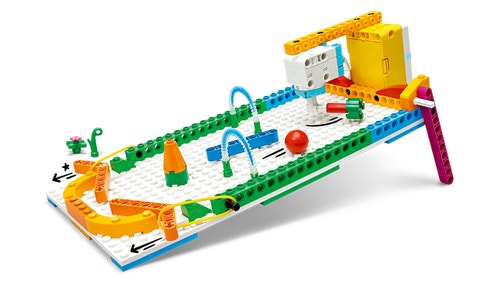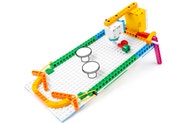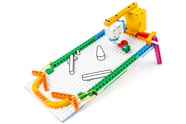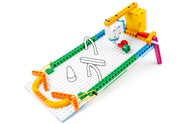SPIKE™ Essential
Junior Pinball
Try Sofie’s junior pinball game and upgrade it to make it more unpredictable!
30-45 min.
Beginner
Grades 3-5

Prepare
- Review the Junior Pinball lesson in the LEGO® Education SPIKE™ App.
- If necessary, pre-teach these related vocabulary words: bumper, flipper, obstacle, predictable, transfer, and unpredictable.
- Consider the abilities and backgrounds of all your students. Differentiate the lesson to make it accessible to everyone. See the Differentiation section below for suggestions.
- If time allows, plan and facilitate the language arts extension. See the Extension section below for more information.
Engage
(Whole Class, 5 Minutes)
- Facilitate a quick discussion about energy conversion.
- Talk with your students about a spinning top.
- Ask questions, like: What type of energy does a spinning top have before it starts spinning? While it’s spinning? How can this energy be converted from one form to another?
- Introduce your students to the story’s main characters and the first challenge: starting the junior pinball game.
- Distribute a brick set and a device to each group.
Explore
(Small Groups, 30 Minutes)
- Have your students use the LEGO® Education SPIKE™ App to guide them through their first challenge:
- Create and test the program that starts the junior pinball game.
- Have your students iterate and test their models to complete the next two challenges in the app:
- Modify the program to make the junior pinball game more unpredictable.
- Upgrade the junior pinball game by adding different obstacles.
- You can find coding and building support in the Tips section below.
Explain
(Whole Class, 5 Minutes)
- Gather your students together to reflect on their completed challenges.
- Ask questions, like: What refinements did you make to change how or when the game converted potential energy to kinetic energy? How did the different obstacles impact the energy conversion?
Elaborate
(Whole Class, 5 Minutes)
- Prompt your students to discuss and reflect on the process of refining their solutions to convert one type of energy to another.
- Ask questions, like: How did the type of obstacle affect the ball's energy? How could you design an obstacle to make the conversion of energy visible?
- Have your students clean up their workstations.
Evaluate
(Ongoing Throughout the Lesson)
- Ask guiding questions to encourage your students to “think aloud” and explain their thought processes and reasoning in the decisions they've made while building and programming.
Observation Checklist
- Measure your students’ proficiency in refining a solution that converts energy from one form to another.
- Create a scale that matches your needs. For example:
- Needs additional support
- Can work independently
- Can teach others
Self-Assessment
- Have each student choose the brick that they feel best represents their performance.
- Yellow: I think I can refine a solution that converts energy from one form to another.
- Blue: I can refine a solution that converts energy from one form to another.
- Green: I can refine a solution that converts energy from one form to another, and I can help a friend do it too.
Peer-Feedback
- In their small groups, have your students discuss their experiences working together.
- Encourage them to use statements like these:
- I liked it when you…
- I'd like to hear more about how you…
Tips
Coding Tip
- After your students complete their first challenge, they'll be provided with three Inspiration Coding Blocks to help them modify their programs.
- The Inspiration Coding Blocks are intended to spark their imaginations as they experiment to find their own solutions.




Model Tip
- After your students complete their second challenge, they’ll be provided with three Inspiration Images and an open-ended prompt for improving their models.
- The Inspiration Images are to help spark their imaginations as they experiment and change their models.




There aren't any building instructions for this challenge.
Differentiation
Simplify this lesson by:
- Selecting one Inspiration Image to help your students change their models
- Limiting the number of obstacles to create and test
Increase the difficulty by:
- Including another motor or sensor in the game
- Exploring new and different coding blocks in the program
Extension
- Have your students research the rules of pinball and write the rules for their own junior pinball games, including how to score points and win.
If facilitated, this will extend beyond the 45-minute lesson.
Language Arts: CCSS.ELA-LITERACY.W.4.2.D
Teacher Support
Students will:
- Apply their ideas to refine a solution that converts energy from one form to another
- Test the solution to improve and refine its function
- Engage effectively in a range of collaborative discussions
(one for every two students)
- LEGO® Education SPIKE™ Essential Set
- Device with the LEGO® Education SPIKE™ App installed
- CSTA 1B-AP-12
- NGSS 4-PS3-4
- ISTE 1.3d
- CCSS.ELA-LITERACY.SL.4.1
- CCSS.MATH.CONTENT.4.G.A.1
Language Arts Extension
- CCSS.ELA-LITERACY.W.4.2.D